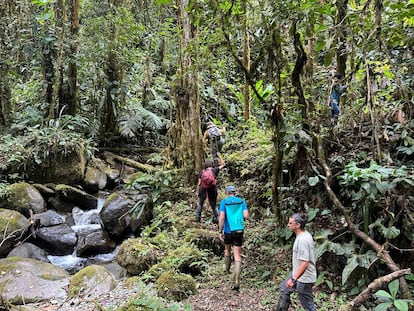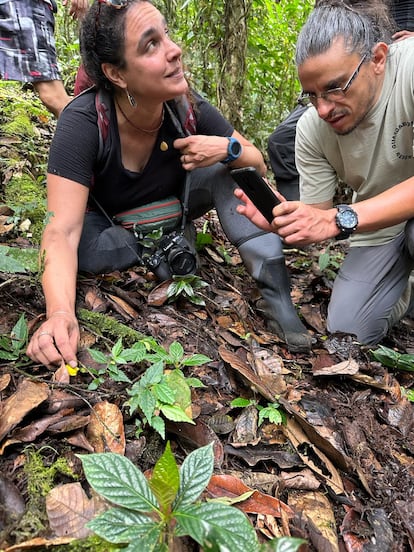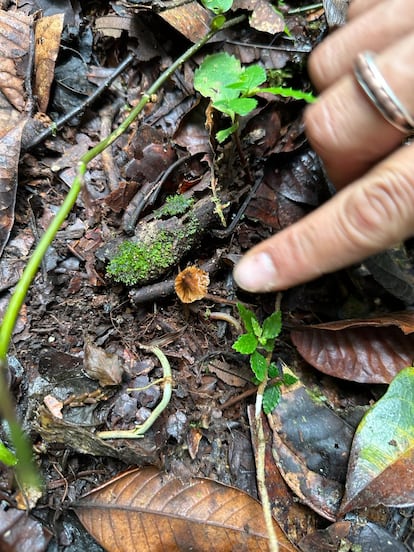How a trial about the rights of nature led to the discovery of a hallucinogenic mushroom in Ecuador
The mushroom was named after Paul Stamets, the most famous mycologist in the world

It was September 2022. In an event room at the Rockefeller Foundation headquarters in New York City, a group of extraordinary people gathered, including philosophers, lawyers, scientists, writers, artists. They were brought together by the More Than Human Rights (MOTH) Project, an interdisciplinary initiative linked to NYU that promotes reflection on why the conception of rights shouldn’t only apply to humans, but also to flora, fauna and fungi.
Among those present were figures such as Andrea Wulf, the German author of The Invention of Nature, a magnificent biography of Alexander von Humboldt; the English writer Robert Macfarlane, considered to be one of the greatest exponents of nature literature; the musician Cosmo Sheldrake (also English), who has recorded albums with the sounds of whales and birds in danger of extinction; the famous Chilean mycologist Giuliana Furci, director of the Fungi Foundation and advocate that — in the understanding of the macroscopic diversity of life — flora and fauna should be integrated with “funga,” the kingdom of fungi that allows the interconnection between all the organisms; the Colombian jurist César Rodríguez-Garavito, director of MOTH, as well as two renowned Ecuadorian lawyers, Agustín Grijalva and Ramiro Ávila. The latter two are former judges who sat on the Constitutional Court, the highest judicial body in Ecuador. Lately, emblematic cases about the rights of nature have been heard in this court. “I was obsessed with declaring that non-human entities whose cases reached the Court should be endowed with rights,” Ávila affirms.
To attend this meeting, all guests had to submit a text on the major topic in question, as observed from their respective disciplines. One document that was mailed in was the sentence handed down in the exemplary case of a forest. Los Cedros Protective Forest is a reserve of 6,000 hectares of a tropical ecosystem, located northwest of the Andes mountain range, in the Ecuadorian province of Imbabura. The nature reserve’s geography — which ranges from 3,000 to 9,000 feet in altitude — is crossed by four rivers and is home to jaguars, monkeys, reptiles, amphibians, 309 species of birds, 236 types of orchids and 600 species of moths… in addition to an entire universe of fungi. Today, it’s owned by the state, but in 1988, the land was purchased by Josef DeCoux, an American environmentalist who once managed the scientific station that lies at the heart of the reserve.

At the end of 2017, Ecuador’s Ministry of the Environment granted a license to the National Mining Company (ENAMI EP) to carry out exploration within the forest. In 2018, the autonomous government of Cotacachi — one of the cantons near the reserve — presented an appeal to the provincial court, to prevent exploration. Citing the Constitution of Ecuador — which, in 2008, became a pioneer in the world for the recognition of the rights of nature — the appeal alleged that the exploration permit violated the protection of water and ecosystems. It also violated the right of the local communities to be consulted about such concessions being granted.
In June 2019, the Provincial Court ruled in favor of Cotacachi. And, despite the appeal filed by ENAMI EP, in December 2021, the Constitutional Court ratified the resolution of the provincial entity and annulled the prospecting permit that had been granted to the mining company.
Agustín Grijalva and Ramiro Ávila were then judges of the Constitutional Court. They voted in favor of protecting the forest. Grijalva, additionally, was the judge who analyzed the case and subsequently drafted the ruling. After Los Cedros won the trial, environmentalists around the world celebrated the victory.
As the various invitees were gathered in New York less than a year later, the case of Los Cedros came up in the conversation. Everyone was amazed, so much so that an enthusiastic Robert Macfarlane immediately proposed that they embark on a trip. The following month, the group landed in Quito. Macfarlane was researching the rights of nature, while Cosmo Sheldrake — carrying various devices — was determined to record the heartbeats of the forest. Rodríguez-Garabito came along, as did Giuliana Furci, who didn’t feel like she had a special mission in mind until just days before embarking on the trip. Dr. Bryn Dentinger — from the University of Utah — told her that, in 2011, in that same Ecuadorian forest, two new specimens of Psilocybe mushrooms were discovered. They contain psychoactive substances, which is why they’re often called hallucinogens. He recommended that she keep an eye out for them, because with a second identification — as dictated by scientific protocol — she could register them officially.
October 24, 2022 was a hot day. Ecuadorian lawyers, biologists, activists and professional guides were waiting to host the group. Along the way, the visitors stopped several times to learn about the environment, thanks to the explanations of the experts. They also bathed in a waterfall, in a moment that represented a celebration of the natural magnificence that had been defended in the courts.
When they returned to the path, Giuliana Furci had a deep premonition. “I felt something special. I felt like the mushroom was there,” she recalls. “And I wondered if I had verbalized it or not… it turns out that I did. I told the others: ‘Hey, I feel like it’s here.’” About 150 feet ahead — solitary and hidden with its brown tone among the humid vegetation — was the mushroom, one of the varieties that Dr. Dentinger had discovered 11 years earlier in the same forest, but on another trail and at another time of year. These differences made the discovery even more significant.
Furci’s father had died a month-and-a-half earlier. She was carrying acute grief. In that moment, her energy connected with the presence of the mushroom — she suddenly found comfort. “There’s a part of you that also dies when a parent dies,” she sighs. “But for me it was a blessing that the connection with the mushroom showed me that he was still alive.”
Excited, she secured the space. Together, they spent a moment contemplating the good fortune of the circumstance. Then came the collection protocol: photographs, descriptive notes, georeferencing. Furci took the mushroom out of the ground, wrapped it in fresh plant leaves (so that it would not dehydrate) and stored it in the metal box that Cosmo Sheldrake had used to carry the medicine. In that imperceptible void left by the fungus, the musician introduced his ultrasensitive contact microphones to record the resonance of the habitat. “To me, it sounds like a stomach digesting, a low-pitched, rumbling, gurgling sound,” Sheldrake says.
The mushroom was no wider than a match. The crown — the cap — was quite pointed. Subsequent analyses determined that the molecular structure was the same as that of one of those discovered in 2011, so it could be registered as a new species. This was done using the Index Fungorum, the electronic publication tool of the Royal Botanic Gardens of Kew, in London, which speeds up registration by circumventing the extended processes of scientific journals. The mushroom had to be given a name.
“For me, Paul Stamets is a mentor-like figure in mycology. He’s dedicated most of his life to studying the fungi of the Psilocybe group,” Furci explains. “But there was no species dedicated to him — much less a Psilocybe — so it seemed appropriate to do it.” Thus Psilocybe stametsii was born.
“I am deeply honored by this recognition and excited to go on a field expedition to see this species in its natural habitat,” the mycologist wrote on social media.

Paul Stamets is perhaps the most famous mycologist in the world, a self-taught individual who has spent almost 50 years researching and publishing books on the subject of fungi. He’s largely responsible for the integration of that cosmos into popular culture. He’s the protagonist of the Netflix documentary Fantastic Mushrooms, while the series Star Trek: Discovery based the character of Lieutenant Stamets on him.
While some were searching through Los Cedros, others were listening to it. With the variety of sounds he recorded in the forest, Cosmo Sheldrake composed a song that will soon be released. He has maintained the theme of his previous albums, in which he uses sounds from nature. The artist — in accordance with the idea of the rights of nature — has recognized the co-authorship of the ecosystems from which the sounds have been taken from. Fifty percent of the royalties from his album Wake Up Calls — which brings together songs from British birds in danger of extinction — were donated to organizations that work in defense of these birds. He did something similar with the album Wild Wet World, built over 10 years with clicks, crackles and splashing from the marine world.
Today — in addition to the still-unnamed song composed with sounds from Los Cedros — he will also engage in profit-sharing when it comes to Lichens, one of the 21 songs in his new album, Eye to the Ear, to be released in April. In this song, he introduces the sounds captured in the land where Psilocybe stametsii was found. Fifteen percent of the publication rights of that song will go to the Fungi Foundation, directed by Giuliana Furci.
“For me, bird songs, for example, are a creative, expressive musical phenomenon. If we attribute agency and consciousness to these creatures, it only seems fair that their creative expressions should be recognized,” Sheldrake affirms. “The same thing happens with the song about Los Cedros, which has sounds of the water, the birds and the bats. Songwriting credits and copyrights should be shared between human and non-human creators.”
The next MOTH meeting will be in April of this year in Quito, Ecuador. Among other topics, Ramiro Ávila and Giuliana Furci will discuss how to make fungi central to the legal argument to defend a territory near Los Cedros from mining exploitation. “If a type of fungus is in danger of extinction, mining activity is a threat,” Ávila explains. “The idea is to declare the fungus has rights, in order to protect the entire ecosystem.”
Sign up for our weekly newsletter to get more English-language news coverage from EL PAÍS USA Edition
Tu suscripción se está usando en otro dispositivo
¿Quieres añadir otro usuario a tu suscripción?
Si continúas leyendo en este dispositivo, no se podrá leer en el otro.
FlechaTu suscripción se está usando en otro dispositivo y solo puedes acceder a EL PAÍS desde un dispositivo a la vez.
Si quieres compartir tu cuenta, cambia tu suscripción a la modalidad Premium, así podrás añadir otro usuario. Cada uno accederá con su propia cuenta de email, lo que os permitirá personalizar vuestra experiencia en EL PAÍS.
¿Tienes una suscripción de empresa? Accede aquí para contratar más cuentas.
En el caso de no saber quién está usando tu cuenta, te recomendamos cambiar tu contraseña aquí.
Si decides continuar compartiendo tu cuenta, este mensaje se mostrará en tu dispositivo y en el de la otra persona que está usando tu cuenta de forma indefinida, afectando a tu experiencia de lectura. Puedes consultar aquí los términos y condiciones de la suscripción digital.
More information

What diseases are caused by fungi?

Fungi, yerba mate waste and cassava starch: Argentina’s alternatives to plastic
Archived In
Últimas noticias
Russell Tovey: ‘I was advised many times not to come out, I don’t think there was many people who’d done that — and I feel really proud that I’m one of those that did’
Patagonia’s puma population soars thanks to unexpected prey: penguins
Merz tries to replace Macron at the helm of Europe
Indulgence, punishment and family dynamics: Maintaining a healthy relationship with food during the holiday season
Most viewed
- The low-cost creative revolution: How technology is making art accessible to everyone
- Families demand repatriation of bodies of Colombians who died in Ukraine: ‘This war is a slaughterhouse for foreigners’
- Christian Louboutin: ‘Young people don’t want to be like their parents. And if their parents wear sneakers, they’re going to look for something else’
- US sanctions against jailed cartel leader ‘El Marro’ highlight Mexico’s lack of control over its prisons
- Liset Menéndez de la Prida, neuroscientist: ‘It’s not normal to constantly seek pleasure; it’s important to be bored, to be calm’








































